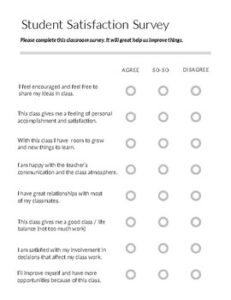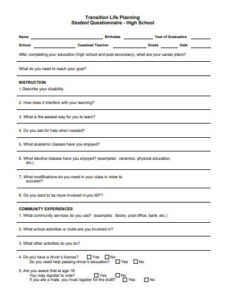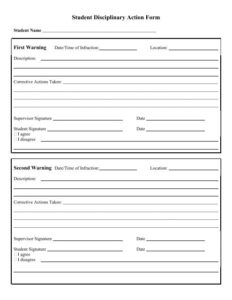Understanding the pulse of your school community is crucial for fostering a positive and productive learning environment. A healthy school climate impacts everything from student engagement and academic performance to teacher retention and parent satisfaction. But gathering this vital feedback can often feel like a monumental task, especially when time and resources are limited.
That’s where the beauty of a quick, streamlined approach comes in. Instead of a lengthy, comprehensive assessment that might overwhelm participants and delay insights, a concise survey offers a powerful way to gauge key aspects of your school’s atmosphere efficiently. This article explores how a well-designed quick school climate survey template can provide actionable data without significant disruption, helping you pinpoint areas of strength and opportunities for growth.
The Power of a Concise School Climate Snapshot
In the dynamic world of education, agility is key. A quick school climate survey template is not about sacrificing depth for speed, but rather about focusing on the most impactful indicators of school health. Think of it as a vital check-up that allows you to address immediate concerns and celebrate successes in a timely manner. This rapid feedback loop is invaluable for administrators and educators who need to make responsive decisions, ensuring that interventions are relevant and support is provided where it’s most needed.
The beauty of a shorter survey lies in its higher completion rates and reduced participant fatigue. When students, teachers, and parents see a survey that respects their time, they are more likely to provide thoughtful responses. This isn’t just about convenience; it’s about making data collection a continuous, less burdensome process, enabling you to track progress over time and measure the impact of your initiatives more effectively. It helps build a culture where feedback is welcomed and acted upon, rather than seen as an annual chore.
Core Elements of an Effective Quick Survey
While brevity is important, a quick school climate survey template still needs to touch on the foundational pillars that contribute to a thriving school community. Here are some critical areas to consider when crafting your questions:
- Safety and Security: Do students and staff feel physically and emotionally safe within the school environment? This includes bullying, harassment, and a sense of physical protection.
- Sense of Belonging: Do individuals feel accepted, valued, and connected to the school community? This covers aspects of inclusion, respect for diversity, and supportive relationships.
- Teaching and Learning Environment: Is the instructional climate conducive to learning? This involves perceptions of teacher support, clear expectations, academic challenge, and engaging lessons.
- Support for Wellbeing: Are there resources and support systems available for mental health, social-emotional learning, and overall student and staff wellbeing?
- Communication and Engagement: How effective is communication within the school, and are there opportunities for meaningful participation from all stakeholders?
By carefully selecting questions that address these areas, even a brief survey can yield powerful insights. The goal is to formulate questions that are clear, concise, and elicit responses that truly reflect the perceptions and experiences of your school community members. Simplicity in language ensures broad understanding and accurate data collection.
From Data to Action: Making Your Survey Results Count
Having a fantastic quick school climate survey template is just the first step; the real magic happens when you turn the collected data into meaningful action. Once your responses are in, the next crucial phase involves analyzing the information and identifying key trends or areas that require attention. Look beyond individual scores to see patterns across different groups, whether it’s by grade level, department, or demographic. This holistic view helps uncover systemic issues or widespread successes that might otherwise be missed.
The analysis doesn’t have to be overly complex. Even with a quick survey, you can identify high-level priorities. Are students indicating concerns about bullying? Are teachers feeling unsupported in a particular area? Is there a noticeable difference in how parents perceive communication versus staff? These insights provide a clear roadmap for where to focus your efforts. Sharing aggregated results, while maintaining anonymity, with your school community can also foster transparency and demonstrate your commitment to improvement.
Perhaps the most vital part of the process is developing concrete action plans based on what the survey reveals. For instance, if the survey highlights a need for more positive behavior reinforcement, your action plan might involve implementing a new recognition program or providing professional development on positive classroom management techniques. If communication emerges as an area for improvement, consider new channels or frequencies for updates to parents and staff. Remember, the goal is not just to collect data, but to inspire tangible change.
Regularly revisiting your quick school climate survey template, perhaps on a bi-annual or even quarterly basis, allows you to track the effectiveness of your interventions and celebrate progress. It’s an ongoing cycle of listening, learning, and improving. This commitment to continuous feedback not only strengthens your school climate over time but also builds trust and demonstrates to students, staff, and parents that their voices are truly heard and valued in shaping their educational environment.
Empowering your school community with a voice through regular, efficient feedback mechanisms is a powerful way to cultivate an environment where everyone feels safe, supported, and ready to thrive. By embracing a focused and frequent approach to understanding your school’s atmosphere, you create a foundation for continuous growth and positive transformation.
Ultimately, the effort invested in consistently checking the pulse of your school yields immense returns, fostering a culture of openness, responsiveness, and collective responsibility that benefits every member of the learning community. It’s about building a better school, one thoughtful response at a time.



